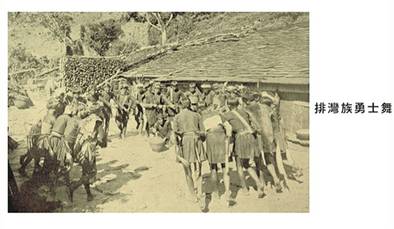
| Japanese viewpoint |
| Ryukyu viewpoint |
| Ch'ing viewpoint |
|
Aboriginal viewpoint |
| Aboriginal civilization |
| Aboriginal history |
| The Mudan Village Incident |
Plains, Mountains and Tribal definitions
For most of their recorded history, Taiwanese Aborigines have been defined
by the agents of different Confucian, Christian, and Nationalist
"civilizing" projects, with a variety of aims. Each "civilizing" project
defined the Aborigines based on the "civilizer’s" cultural understandings of
difference and similarity, behavior, location, appearance and prior contact
with other groups of people (Harrell 1995:5–20). Taxonomies imposed by
colonizing forces divided the Aborigines into named subgroups, referred to
as "tribes". These divisions did not always correspond to distinctions drawn
by the Aborigines themselves. However, the categories have become so firmly
established in government and popular discourse over time that they have
become de facto distinctions, serving to shape in part today’s political
discourse within the Republic of China (ROC), and affecting Taiwan’s
policies regarding indigenous peoples.
Confucian, Christian, and Nationalist
"civilizing" projects, with a variety of aims. Each "civilizing" project
defined the Aborigines based on the "civilizer’s" cultural understandings of
difference and similarity, behavior, location, appearance and prior contact
with other groups of people (Harrell 1995:5–20). Taxonomies imposed by
colonizing forces divided the Aborigines into named subgroups, referred to
as "tribes". These divisions did not always correspond to distinctions drawn
by the Aborigines themselves. However, the categories have become so firmly
established in government and popular discourse over time that they have
become de facto distinctions, serving to shape in part today’s political
discourse within the Republic of China (ROC), and affecting Taiwan’s
policies regarding indigenous peoples.
The Han sailor, Chen Di, in his Record of the Eastern Seas (1603),
identifies the indigenous people of Taiwan as simply (Dong Fan) 東番, or
"Eastern Savage", while the Dutch referred to Taiwan’s original inhabitants
as "Indians" or "blacks", based on their prior colonial experience in what
is currently Indonesia (Teng 2004:61–65).
Beginning nearly a century later, as the rule of the Ching Empire expanded
over wider groups of people, writers and gazetteers recast their
descriptions away from reflecting degree of acculturation, and toward a
system that defined the Aborigines relative to their submission or hostility
to Ching rule. Ching literati used the term "raw/wild" ("生番") to define
those people who had not submitted to Ching rule, and "cooked/tame" ("熟番")
for those who had pledged their allegiance through their payment of a head
tax. According to the standards of the Qianlong Emperor and successive
regimes, "cooked" was synonymous with having assimilated to Han cultural
norms, and living as a subject of the Empire, but retained a pejorative
designation to signify the perceived cultural lacking of the non-Han people
(Harrell 1995:19), (Diamond 1995:100). This designation reflected the
prevailing idea that anyone could be civilized/tamed by adopting Confucian
social norms (Crossley 1999:281–295; Dikotter 1992:8–9).
As the Ching consolidated their power over the plains and struggled to enter
the mountains in the late 19th century, the terms "Plains tribes" (lowland)
Pepo or Pingpu zu 平埔族 and "High Mountain tribes" (highland) Gao shan zu 高山族
were used interchangeably with the terms "Raw" and "Cooked" (Teng
2004:125–127). During the 50 years of Japanese colonial rule (1895–1945),
anthropologists from Japan maintained the binary classification. In 1900
they incorporated it into their own colonial project by employing the term
Peipo (Plains Aborigine) for the "cooked tribes", and creating a category of
"recognized tribes" for the Aborigines who had formerly been called "raw".
They referred to them as takasagozoku (高砂族). The latter group included the
Atayal, Bunun, Tsou, Saisiat, Paiwan, P uyuma, and Ami peoples. The Yami
(Tao) and Thao were added later, for a total of nine recognized tribes
(Harrison 2001:54–55). During the early period of Chinese Nationalist
Kuomintang (KMT) rule the terms Shandi Tongbao 山地同胞 "mountain compatriots"
and Pingdi Tongbao 平地同胞 "plains compatriots" were invented, to remove the
presumed taint of Japanese influence and reflect the place of Taiwan’s
indigenous people in the Chinese Nationalist state (Harrison 2001:60). The KMT later adopted the use of all the earlier Japanese groupings except "Peipo".
uyuma, and Ami peoples. The Yami
(Tao) and Thao were added later, for a total of nine recognized tribes
(Harrison 2001:54–55). During the early period of Chinese Nationalist
Kuomintang (KMT) rule the terms Shandi Tongbao 山地同胞 "mountain compatriots"
and Pingdi Tongbao 平地同胞 "plains compatriots" were invented, to remove the
presumed taint of Japanese influence and reflect the place of Taiwan’s
indigenous people in the Chinese Nationalist state (Harrison 2001:60). The KMT later adopted the use of all the earlier Japanese groupings except "Peipo".
Despite recent changes in the field of anthropology and a shift in Taiwanese
government objectives, the Gaoshan and Pingpu labels in use today maintain
the form given by the Ching to reflect Aborigines’ acculturation to Han
culture. The current recognized Aborigines are all regarded as Gaoshan,
though the divisions are not and have never been based strictly on
geographical location. The Amis, Saisiat, Tao and Kavalan are all
traditionally eastern plains cultures (Brown 2001:163 n6). The distinction
between Plains and Gaoshan people continues to affect Taiwan’s policies
regarding indigenous peoples, and their ability to participate effectively
in government (Saisiyat people 2006).


Although the ROC’s Government Information Office officially lists 13 major
groupings as "tribes" the consensus among scholars maintains that these 13
groupings do not reflect any social entities, political collectives, or
self-identified alliances dating from pre-modern Taiwan (Teng 2004:104–105).
The earliest detailed records, dating from the Dutch arrival in 1624,
describe the Aborigines as living in independent villages of varying size.
Between these villages there was frequent trade, intermarriage, warfare and
alliances against common enemies. Using contemporary ethnographic and
linguistic criteria, these villages have been classed by anthropologists
into more than 20 broad (and widely debated) ethnic groupings (Tsuchida
1983:62; Li 1992:22–23), which were never united under a common polity,
kingdom or "tribe" (Shepherd 1993:51–61).
Reference
http://www.taiwandna.com/AboriginePage.html
http://www.flickr.com/photos/abohome/412316891/in/set-72157594572945211/